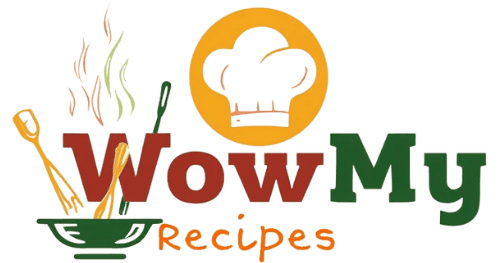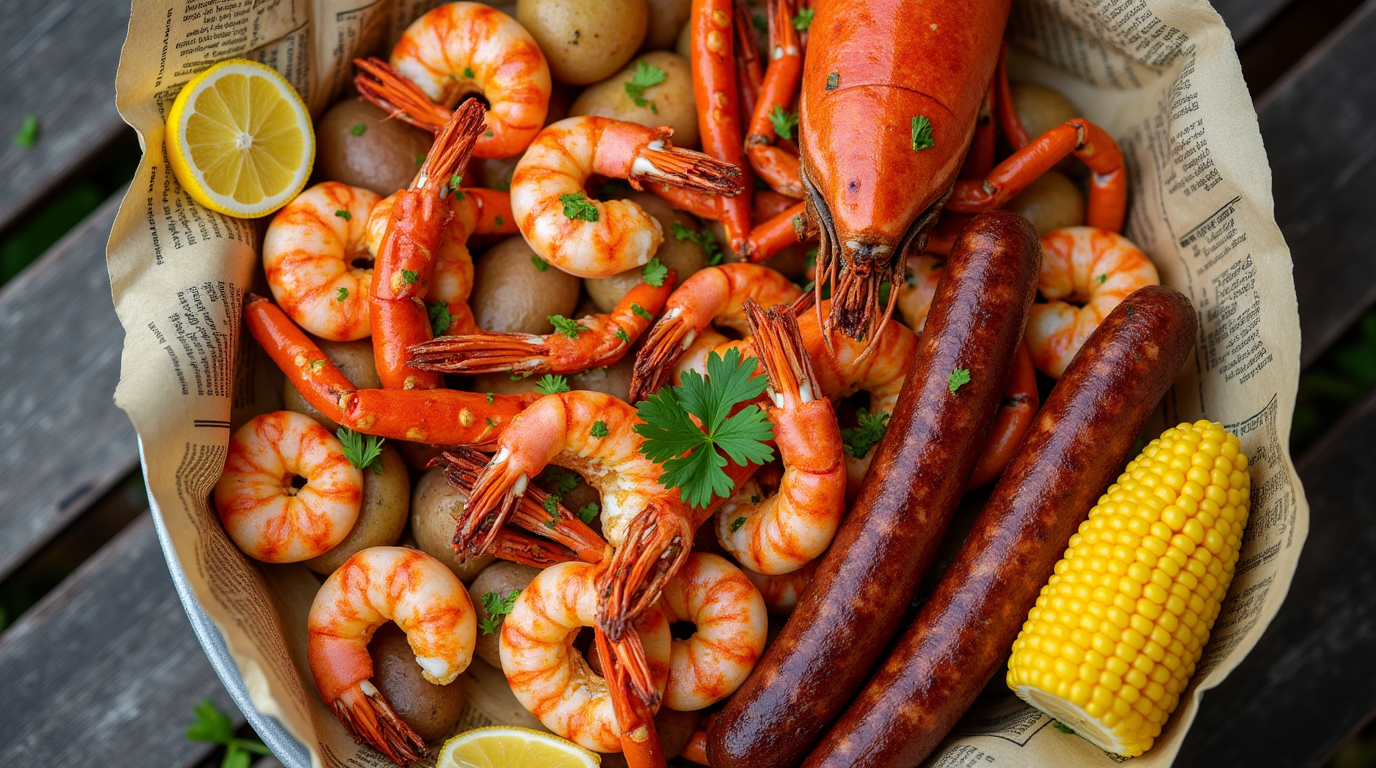Cajun Seafood Boil Recipe – Spicy, Flavorful, and Easy to Make
I am excited to share with you a delicious and authentic Cajun seafood boil recipe that is sure to become a favorite. This spicy and flavorful dish is perfect for gatherings and is surprisingly easy to prepare.
In this article, we will explore the key ingredients and steps involved in making a mouth-watering Cajun seafood boil. You will learn how to combine the freshest seafood with a blend of spices to create a truly unforgettable culinary experience.
Key Takeaways
- Learn how to make an authentic Cajun seafood boil recipe
- Discover the key ingredients and spices required for the dish
- Understand the steps involved in preparing a delicious seafood boil
- Get tips on customizing the recipe to suit your taste
- Explore the benefits of cooking a seafood boil for gatherings
The Rich History of Cajun Seafood Boils in Louisiana
The Cajun seafood boil, a staple of Louisiana’s culinary scene, has a rich history that spans centuries. This traditional dish, known for its bold flavors and hearty portions, is deeply rooted in the state’s cultural heritage.
Origins and Cultural Significance
The origins of the Cajun seafood boil are closely tied to the Acadian people, who were French colonists that settled in Louisiana. As Julia Reed once said, “Cajun cuisine is a true reflection of the Acadian people’s resourcefulness and love for good food.” Their culinary traditions were shaped by the abundant seafood available in the region, including crawfish, shrimp, and crab. The seafood boil became a staple due to its simplicity and the fact that it brought people together. It was a meal that could be prepared in large quantities, making it a central part of community gatherings and celebrations.
From Necessity to Celebration
Initially, seafood boils were a practical meal, born out of necessity from the Acadian people’s need to cook seafood quickly and efficiently. Over time, however, the seafood boil evolved into a celebratory dish, often served at festivals, family gatherings, and other social events. As Chef John Folse notes, “The seafood boil is a true celebration of Louisiana’s culinary heritage.” Today, it’s a beloved tradition that continues to bring people together, showcasing the rich cultural heritage of Louisiana.
What Makes an Authentic Cajun Seafood Boil
An authentic Cajun Seafood Boil is more than just a meal, it’s a celebration of Louisiana’s rich cultural heritage. At its core, this dish is a reflection of the state’s history, geography, and the people who have shaped its cuisine over centuries.
Key Flavor Profiles in Cajun Cooking
Cajun cuisine is known for its bold and robust flavors, which are achieved through a combination of ingredients and cooking techniques. The key flavor profiles in a traditional Cajun Seafood Boil include the spicy kick from cayenne pepper and hot sauce, the depth of flavor from smoked paprika and garlic, and the freshness of seafood. These elements come together to create a dish that is both hearty and refined.
| Flavor Component | Contribution to Dish |
|---|---|
| Cayenne Pepper | Adds a spicy kick |
| Smoked Paprika | Provides depth of flavor |
| Garlic | Enhances overall flavor profile |
Regional Variations Across Louisiana
Louisiana is a state with a rich culinary diversity, and the Cajun Seafood Boil is no exception. Regional variations can be seen in the choice of seafood, with some areas favoring shrimp and crab over others. Additionally, the level of spiciness and the use of certain ingredients can vary significantly from one region to another, reflecting local preferences and traditions.
Essential Ingredients for Your Cajun Seafood Boil
The foundation of a mouth-watering Cajun Seafood Boil lies in its ingredients, which I’ll guide you through in detail. To create this flavorful dish, you’ll need a mix of fresh seafood, aromatic vegetables, and a blend of spices that give it that authentic Cajun taste.
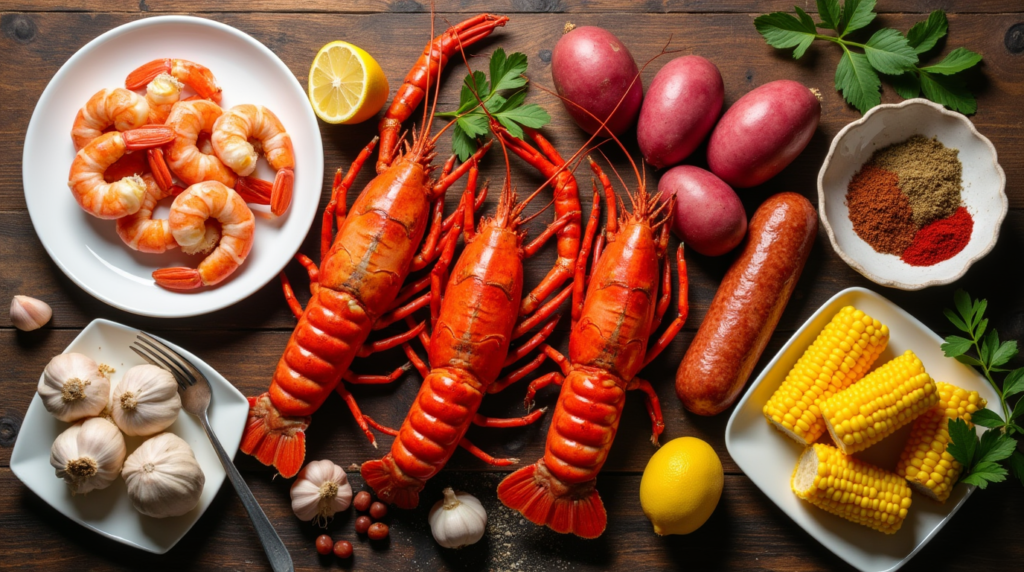
Seafood Selection Guide
Selecting the right seafood is crucial for a delicious Cajun Seafood Boil. The mix typically includes a variety of shellfish and fish that complement each other in texture and flavor.
Shellfish Options
For shellfish, you can choose from shrimp, crawfish, crab legs, and clams or oysters if you prefer. Shrimp and crawfish are staples in a traditional Cajun boil, providing that unmistakable flavor and texture.
Fish Recommendations
For fish, redfish, catfish, or tilapia can be used, though the choice often depends on personal preference and availability. These fish absorb the flavors of the boil well and add variety to the dish.
Vegetables and Aromatics
Vegetables and aromatics play a vital role in adding depth to your Cajun Seafood Boil. They are boiled along with the seafood, infusing the dish with their flavors.
Traditional Additions
Traditional additions include potatoes, corn on the cob, and smoked sausage. These ingredients are classic in Cajun cuisine and complement the seafood beautifully.
Creative Variations
For a creative twist, you can add artichokes, carrots, or even garlic cloves to the boil. These additions can enhance the flavor profile and make the dish more interesting.
Shopping List and Quantities
Here’s a basic shopping list and quantities for a typical Cajun Seafood Boil serving 4-6 people:
| Ingredient | Quantity |
|---|---|
| Shrimp | 1-2 pounds |
| Crawfish | 1-2 pounds |
| Crab Legs | 2-3 pounds |
| Smoked Sausage | 1 pound |
| Potatoes | 2-3 large |
| Corn on the Cob | 4-6 ears |
Adjust the quantities based on your family’s preferences and appetite.
Creating the Best Cajun Seafood Boil Seasoning
The essence of a Cajun Seafood Boil is captured in its carefully crafted seasoning blend. This crucial component elevates the dish, infusing the seafood and vegetables with the bold, spicy flavors characteristic of Cajun cuisine.
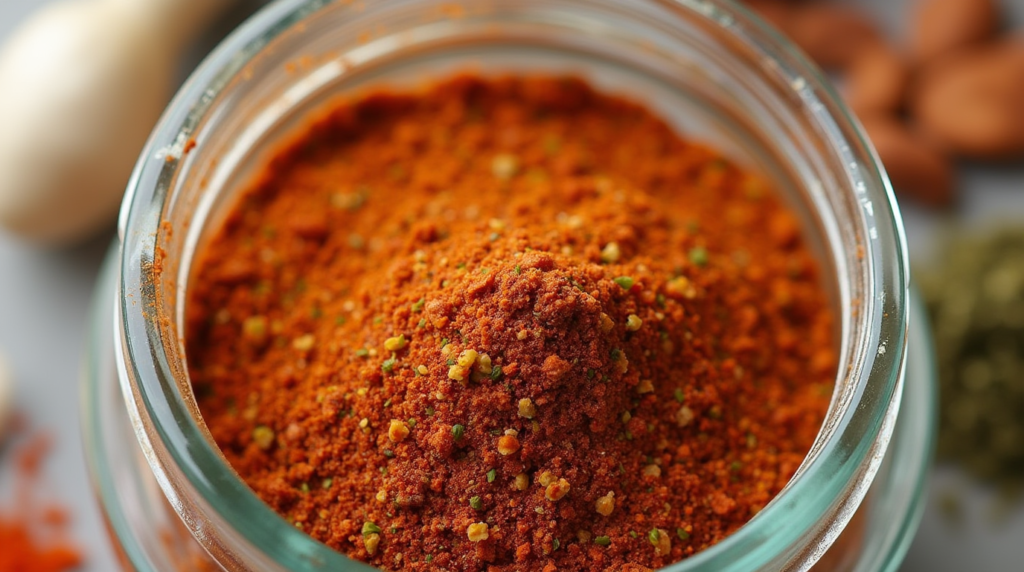
Homemade Seasoning Blend Recipe
Creating your own Cajun seasoning blend from scratch allows you to customize the flavor to your liking. It’s surprisingly simple and requires just a few ingredients.
Essential Spices
The foundation of a great Cajun seasoning lies in its balance of spices. Key ingredients include paprika, garlic powder, onion powder, cayenne pepper, thyme, oregano, and black pepper. Each of these components plays a vital role in achieving that authentic Cajun flavor.
Mixing and Storage Tips
To mix your seasoning blend, simply combine the spices in the desired proportions. Store the blend in an airtight container to preserve its potency. I recommend using a glass jar with a tight-fitting lid. This will keep your seasoning fresh for a longer period.
Store-Bought Alternatives and Recommendations
If making your own seasoning blend isn’t feasible, several excellent store-bought options are available. Brands like Zatarain’s and Old Bay offer high-quality Cajun seasoning blends that can be used as a substitute. When choosing a store-bought blend, look for one that lists its ingredients clearly and doesn’t contain fillers or artificial additives.
By choosing the right Cajun Seafood Boil seasoning, whether homemade or store-bought, you’ll be well on your way to creating a delicious and authentic Louisiana-style seafood boil.
Equipment You’ll Need for a Successful Boil
To host a memorable Louisiana seafood boil, having the right equipment is crucial. A well-prepared cooking station not only ensures that the boil is executed smoothly but also enhances the overall experience for your guests.
Pot Size and Material Considerations
The pot is the centerpiece of your Cajun seafood boil. A large pot, typically 30-quart or larger, is recommended to accommodate a generous amount of seafood and other ingredients. When it comes to material, a heavy-duty, propane-fueled pot is ideal for outdoor boils, while a large stockpot works well for indoor cooking. Consider a pot made from durable materials like stainless steel or enameled cast iron for even heat distribution.
Additional Tools and Accessories
Beyond the pot, several tools are essential for a successful boil. These include a strainer or basket to hold the seafood and vegetables, tongs or a large slotted spoon for serving, and a thermometer to monitor the temperature. Additionally, having plenty of newspaper or tablescloths for covering the table, as well as plates, utensils, and napkins, will help create a festive atmosphere.
Setting Up Your Cooking Station
Setting up your cooking station efficiently is key to a smooth operation. Position your pot over the heat source, whether it’s a propane burner or a large stovetop, and have all your ingredients and tools within easy reach. Organizing your space in this way allows you to focus on cooking and enjoying the experience with your guests.
Step-by-Step Cajun Seafood Boil Recipe
Now that we’ve covered the essentials, let’s dive into the step-by-step guide on how to make a delicious Cajun seafood boil. This recipe is designed to serve 4-6 people and can be adjusted based on your preferences and the number of guests you’re hosting.
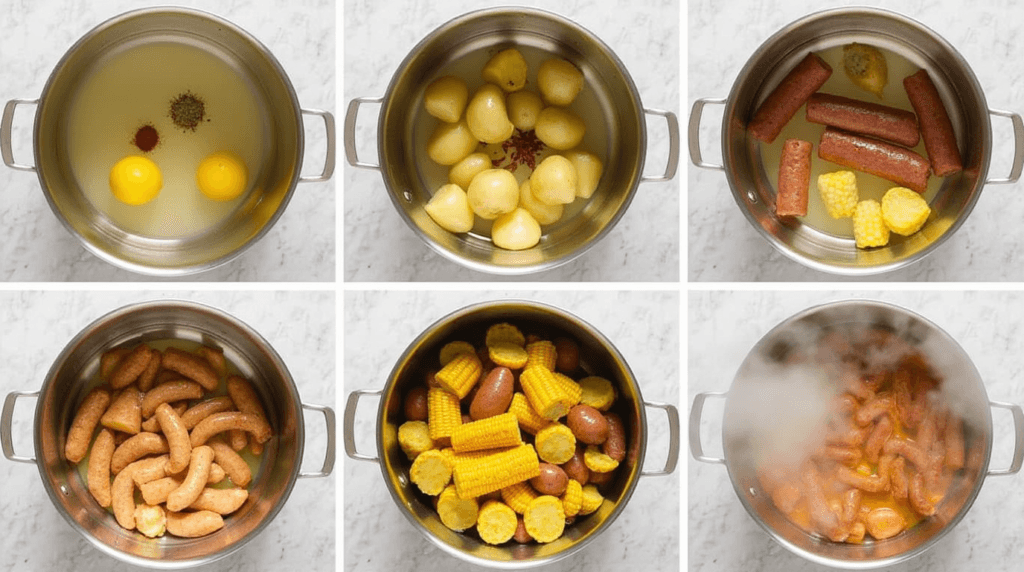
Preparation and Mise en Place
Before we start cooking, it’s crucial to have all our ingredients ready and within reach. This process, known as mise en place, is fundamental in Cajun cooking. Begin by cleaning and preparing your seafood: rinse the shrimp, mussels, and crab legs under cold water. If using live crabs or crawfish, ensure they’re purged and cleaned. Slice the smoked sausage into bite-sized pieces and cut the corn into halves or thirds, depending on their size. Peel the onions and potatoes, and cut them into appropriate sizes for boiling.
Key preparation steps include:
- Rinsing and preparing the seafood
- Slicing the smoked sausage
- Cutting vegetables to the right size
- Having your Cajun seasoning blend ready
The Cooking Process
Cooking a Cajun seafood boil is all about layering flavors and cooking ingredients according to their cooking times. Let’s break down the process further.
Creating the Flavor Base
The foundation of a great Cajun seafood boil is its flavor base, which typically consists of aromatics like onions, lemons, and a generous amount of Cajun seasoning. Start by filling a large pot with enough water to cover all your ingredients. Add sliced onions, lemons, garlic, and your homemade or store-bought Cajun seasoning. Bring this mixture to a rolling boil.
Adding Ingredients in the Right Order
Once your flavor base is boiling, it’s time to add the ingredients. Start with the items that take the longest to cook. Typically, this means adding potatoes and smoked sausage first. After 5-7 minutes, or once the potatoes are nearly tender, add the corn and continue to boil for another 3-4 minutes. Finally, add the seafood, starting with the items that take the longest to cook, such as crab legs and crawfish, followed by shrimp and mussels.
Timing and Temperature Control
Maintaining the right temperature and cooking time is crucial. Ensure the boil is vigorous but not so violent that it boils over. Adjust the heat as necessary. The cooking time will vary depending on the ingredients, but a general rule is to cook until the seafood is done and the vegetables are tender.
How to Know When Everything is Perfectly Cooked
The key to a successful Cajun seafood boil is knowing when to stop cooking. The seafood should be cooked through but not overcooked. Shrimp should be pink and firm, mussels should be open, and crab legs should be hot and flaking easily. Vegetables should be tender. It’s better to check frequently towards the end of the cooking time to avoid overcooking.
By following these steps, you’ll be able to create a delicious and authentic Cajun seafood boil that’s sure to impress your family and friends.
Serving Your Cajun Seafood Boil with Style
A well-presented authentic Cajun seafood boil recipe is not just about the taste; it’s a feast for the eyes too. The way you serve your spicy seafood boil can significantly enhance the overall dining experience.
Traditional Presentation Methods
There are several traditional ways to present your Cajun Seafood Boil, each with its own charm.
The Newspaper Spread Technique
The newspaper spread is a classic method that adds to the authenticity of the meal. Simply spread a layer of newspaper on a large table or surface, dump the boiled seafood and vegetables on top, and garnish with lemon wedges. This method not only looks great but also makes cleanup easier.
Serving Bowls and Platters
For a more refined presentation, consider using large serving bowls or platters. You can arrange the seafood and vegetables neatly, making it easier for guests to serve themselves. Using bowls or platters also allows you to add garnishes like fresh parsley or dill.
Accompaniments and Side Dishes
To complement your authentic Cajun seafood boil recipe, consider serving some traditional side dishes. Here are a few suggestions:
- Cornbread: A classic Southern staple that pairs perfectly with the spicy flavors of the boil.
- Hushpuppies: These deep-fried cornbread balls are a delicious accompaniment.
- Coleslaw: A refreshing side that helps balance the spiciness.
- Garlic Bread: For a simpler option, garlic bread can be a satisfying side dish.
These accompaniments not only add variety to your meal but also enhance the overall flavor profile of your spicy seafood boil.
Adjusting Your Cajun Seafood Boil for Dietary Needs
One of the best things about Cajun Seafood Boil is its flexibility to accommodate various dietary requirements. Whether you’re dealing with spice sensitivity, seafood allergies, or other dietary restrictions, you can still enjoy this flavorful dish with a few adjustments.
Lower-Spice Variations
If you’re not comfortable with the heat level of traditional Cajun Seafood Boil, you can easily reduce the spice. Start by using less of the Cajun seasoning blend or omit the hot sauce altogether. You can also substitute some of the spicy ingredients with milder alternatives, such as using sweet paprika instead of hot paprika.
Seafood Substitutions for Allergies
For those with seafood allergies, it’s crucial to substitute the seafood with allergy-friendly alternatives. While maintaining the essence of the boil, you can replace seafood with smoked sausage or chicken. However, if you’re looking to keep it seafood-friendly but need to avoid certain types, you can swap out specific seafood for others. For instance, if you’re allergic to shellfish, you can focus on fish like catfish or tilapia.
Gluten-Free and Other Dietary Considerations
Making your Cajun Seafood Boil gluten-free is relatively straightforward. Ensure that your Cajun seasoning is gluten-free, as some brands may include gluten-containing ingredients. Additionally, be mindful of the broth or stock you use; opt for a gluten-free version or make your own. Other dietary considerations include using low-sodium broth for those on a low-sodium diet or adjusting the amount of butter and oil for a lower-fat version.
Here’s a simple table to help you navigate common dietary adjustments for your Cajun Seafood Boil:
| Dietary Need | Adjustment |
|---|---|
| Lower Spice | Reduce Cajun seasoning, omit hot sauce |
| Seafood Allergy | Substitute with sausage or chicken |
| Gluten-Free | Use gluten-free Cajun seasoning and broth |
Storing and Reheating Leftover Seafood Boil
Proper storage and reheating techniques are crucial to enjoying your leftover Cajun Seafood Boil. When done correctly, you can savor the flavors of Louisiana even on the second day.
Proper Storage Techniques
To maintain the freshness of your leftover seafood boil, it’s essential to store it correctly. First, allow the boil to cool down to room temperature within two hours of cooking. Then, transfer the leftovers to airtight containers, making sure to separate the seafood from the vegetables and broth if possible. This helps prevent the seafood from becoming soggy. Store the containers in the refrigerator at a temperature below 40°F (4°C).
Tip: Label the containers with the date and contents to ensure you use the leftovers within a day or two.
Best Methods for Reheating Without Overcooking
When reheating your leftover Cajun Seafood Boil, it’s crucial to avoid overcooking the seafood. One effective method is to reheat the broth first, bringing it to a gentle simmer. Then, add the seafood and vegetables, heating them through until just warmed. Alternatively, you can reheat the components separately: steam the seafood and vegetables while gently warming the broth on the stovetop or in the microwave.
By following these steps, you can enjoy your leftover Cajun Seafood Boil with minimal loss of flavor and texture.
Conclusion: Enjoying Your Homemade Cajun Feast
Preparing a traditional Cajun seafood boil is a rewarding experience that brings the flavors of Louisiana to your table. With the simple steps outlined in this article, you can create a delicious and authentic Cajun seafood boil that will impress your family and friends.
The beauty of this recipe lies in its flexibility and the joy it brings to those who gather around the table. Feel free to experiment with different seafood options and spice levels to make the dish your own. As you enjoy the fruits of your labor, remember that the essence of a Cajun seafood boil lies not just in the food, but in the company and the celebration of Louisiana’s rich culinary heritage.
Whether you’re hosting a large gathering or enjoying a quiet meal, your homemade Cajun seafood boil is sure to become a favorite. So go ahead, dig in, and savor the flavors of this traditional Cajun seafood boil. Your taste buds will be treated to a truly unforgettable experience.
FAQ
What is a Cajun Seafood Boil?
A Cajun Seafood Boil is a traditional Louisiana dish that typically includes a variety of seafood such as shrimp, crab, and crawfish, boiled together with vegetables and spices.
What are the key ingredients in a Cajun Seafood Boil?
The key ingredients include a mix of seafood, smoked sausage, potatoes, corn, and a blend of spices known as Cajun or Creole seasoning, which gives the dish its distinctive flavor.
How do I make a homemade Cajun Seafood Boil seasoning blend?
To make a homemade Cajun Seafood Boil seasoning, combine ingredients like paprika, garlic powder, onion powder, cayenne pepper, thyme, oregano, salt, and black pepper. The exact proportions can be adjusted to taste.
Can I adjust the spice level in a Cajun Seafood Boil?
Yes, the spice level can be adjusted by adding more or less of the spicy ingredients, such as cayenne pepper or hot sauce, to suit your taste preferences.
What type of seafood is best for a Cajun Seafood Boil?
A variety of seafood can be used, but common choices include shrimp, crawfish, crab legs, and sometimes fish like cod or tilapia. The choice often depends on personal preference and regional availability.
How do I store and reheat leftover Cajun Seafood Boil?
Leftovers should be stored in airtight containers in the refrigerator and reheated gently, either on the stovetop or in the microwave, to prevent overcooking the seafood.
Can I make a Cajun Seafood Boil gluten-free?
Yes, to make a gluten-free Cajun Seafood Boil, ensure that the seasoning blend and any other ingredients used are gluten-free, and be mindful of cross-contamination.
What are some traditional accompaniments to a Cajun Seafood Boil?
Traditional accompaniments include crusty bread, lemon wedges, and sometimes side dishes like coleslaw or a green salad to provide a contrast to the rich flavors of the boil.
How do I achieve the best flavor in my Cajun Seafood Boil?
Achieving the best flavor involves using a good quality Cajun seasoning, not overcooking the seafood, and ensuring that the ingredients are fresh and of high quality.
Leave a Review & Rate This Recipe!
There are no reviews yet. Be the first one to write one.
